
Concept explainers
(a)
Interpretation:
The IUPAC name of the given molecule is to be written.
Concept introduction:
The root name of the molecule is the name of the
Answer to Problem A.45P
The IUPAC name of the given molecule is
Explanation of Solution
The given molecule is:

In this molecule, the six carbons ring act as a parent. Hence, the root is cyclohexane. The ring has two substituents

The ring is numbered in a way that the carbon to which the
Hence, the IUPAC name is
The IUPAC name of the given molecule is written as
(b)
Interpretation:
The IUPAC name of the given molecule is to be written.
Concept introduction:
The root name of the molecule is the name of the alkane which depends on the longest continuous chain of carbon atoms. The name of the substituent attached to the parent chain is written as a prefix to the left side of the root. The chain is numbered such that the carbon atom to which the substituent is attached, gets the lowest possible number. This number is written on the left side of the substituent and separated by a hyphen. If more than one substituent is present, then the numbering is determined by the alphabetical order of substituents.
Answer to Problem A.45P
The IUPAC name of the given molecule is
Explanation of Solution
The given molecule is:
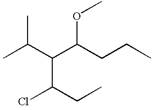
In this molecule, the longest continuous chain of carbon atoms has eight carbon atoms. Hence, the root is octane.
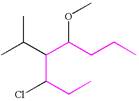
The parent chain has three substituents, thus the chain is numbered so as to provide the lowest set of locants.
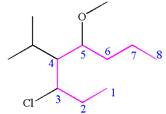
Hence, the IUPAC name is
The IUPAC name of the given molecule is written as
(c)
Interpretation:
The IUPAC name of the given molecule is to be written.
Concept introduction:
The root name of the molecule is the name of the alkane which depends on the longest continuous chain of carbon atoms or the ring structure. The name of the substituent attached to the parent chain is written as a prefix to the left side of the root.
Answer to Problem A.45P
The IUPAC name of the given molecule is
Explanation of Solution
The given molecule is:
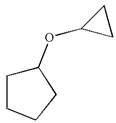
In this molecule, the five carbons ring is a parent. Hence, the root is cyclopentane. Since the ring has only one substituent, there is no need to number the ring to decide the position of the substituent.
Hence, the IUPAC name is
The IUPAC name of the given molecule is written as
(d)
Interpretation:
The IUPAC name of the given molecule is to be written.
Concept introduction:
The root name of the molecule is the name of the alkane which depends on the longest continuous chain of carbon atoms or the ring structure. The name of the substituent attached to the parent ring is written as a prefix to the left side of the root. The parent ring is numbered such that the carbon atom to which the substituent is attached, gets the lowest possible number. This number is written on the left side of the substituent and separated by a hyphen. If more than one substituent is present, then the numbering is determined by the alphabetical order of substituents.
Answer to Problem A.45P
The IUPAC name of the given molecule is
Explanation of Solution
The given molecule is:
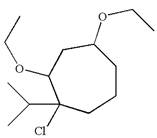
In this molecule, the seven carbons ring is a parent. Hence, the root is cycloheptane. The ring has four substituents, thus the ring is numbered so as to provide the lowest set of locants.
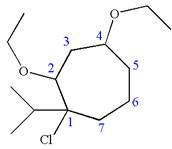
Hence, the IUPAC name is
The IUPAC name of the given molecule is written as
(e)
Interpretation:
The IUPAC name of the given molecule is to be written.
Concept introduction:
The root name of the molecule is the name of the alkane which depends on the longest continuous chain of carbon atoms. The name of the substituent attached to the parent chain is written as a prefix to the left side of the root. The chain is numbered such that the carbon atom to which the substituent is attached, gets the lowest possible number. This number is written on the left side of the substituent and separated by a hyphen. If more than one substituent is present then the numbering is determined by the alphabetical order of substituents.
Answer to Problem A.45P
The IUPAC name of the given molecule is
Explanation of Solution
The given molecule is:
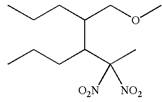
In this molecule, the longest continuous chain of carbon atoms has eight carbon atoms. Hence, the root is octane.
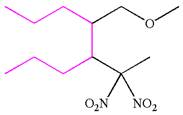
The parent chain has two substituents, thus the chain is numbered so as to provide the lowest set of locants according to alphabetical order.
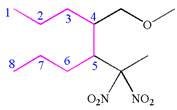
Hence, the IUPAC name is
The IUPAC name of the given molecule is written as
(f)
Interpretation:
The IUPAC name of the given molecule is to be written.
Concept introduction:
The root name of the molecule is the name of the alkane which depends on the longest continuous chain of carbon atoms or the ring structure. The name of the substituent attached to the parent ring is written as a prefix to the left side of the root. The parent ring is numbered such that the carbon atom to which the substituent is attached, gets the lowest possible number. This number is written on the left side of the substituent and separated by a hyphen. If more than one substituent present then numbering is determined by the alphabetical order of substituents in a way to provide the lowest set of locants.
Answer to Problem A.45P
The IUPAC name of the given molecule is
Explanation of Solution
The given molecule is:
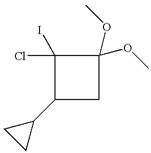
In this molecule, the four carbons ring is a parent. Hence, the root is cyclobutane. The ring has five substituents, thus the ring is numbered so as to provide the lowest set of locants.
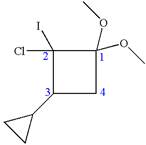
Hence, the IUPAC name is
The IUPAC name of the given molecule is written as
(g)
Interpretation:
The IUPAC name of the given molecule is to be written.
Concept introduction:
The root name of the molecule is the name of the alkane which depends on the longest continuous chain of carbon atoms or the ring structure. The name of the substituent attached to the parent ring is written as a prefix to the left side of the root. The parent ring is numbered such that the carbon atom to which the substituent is attached, gets the lowest possible number. This number is written on the left side of the substituent and separated by a hyphen. If more than one substituent is present, then the numbering is determined by the alphabetical order of substituents.
Answer to Problem A.45P
The IUPAC name of the given molecule is
Explanation of Solution
The given molecule is:
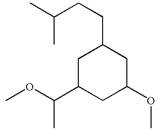
In this molecule, the six carbons ring is a parent. Hence, the root is cyclohexane. The ring has three substituents, thus the ring is numbered so as to provide the lowest set of locants.
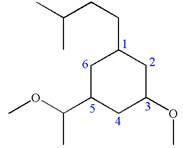
Hence, the IUPAC name is
The IUPAC name of the given molecule is written as
(h)
Interpretation:
The IUPAC name of the given molecule is to be written.
Concept introduction:
The root name of the molecule is the name of the alkane which depends on the longest continuous chain of carbon atoms. The name of the substituent attached to the parent chain is written as a prefix to the left side of the root. The chain is numbered such that the carbon atom to which the substituent is attached, gets the lowest possible number. This number is written on the left side of the substituent and separated by a hyphen. If more than one substituent is present, then the numbering is determined by the alphabetical order of substituents.
Answer to Problem A.45P
The IUPAC name of the given molecule is
Explanation of Solution
The given molecule is:
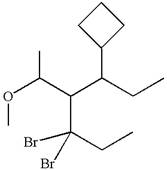
In this molecule, the longest continuous chain of carbon atoms has eight carbon atoms. Hence, the root is octane.
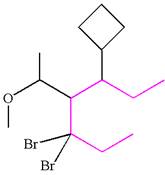
The parent chain has two substituents, thus the chain is numbered so as to provide the lowest set of locants.
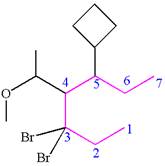
Hence, the IUPAC name is
The IUPAC name of the given molecule is written as
Want to see more full solutions like this?
Chapter A Solutions
Organic Chemistry: Principles And Mechanisms
- Using wedge-and-dash bonds, modify the bonds on the chiral carbon in the molecule below so the molecule has R stereochemical configuration. NH H Br X टेarrow_forwardProvide photos of models of the following molecules. (Include a key for identification of the atoms) 1,2-dichloropropane 2,3,3-trimethylhexane 2-bromo-3-methybutanearrow_forwardPlease draw the structure in the box that is consistent with all the spectral data and alphabetically label all of the equivalent protons in the structure (Ha, Hb, Hc....) in order to assign all the proton NMR peaks. The integrations are computer generated and approximate the number of equivalent protons. Molecular formula: C13H1802 14 13 12 11 10 11 (ppm) Structure with assigned H peaks 2.08 3.13arrow_forward
- A 0.10 M solution of acetic acid (CH3COOH, Ka = 1.8 x 10^-5) is titrated with a 0.0250 M solution of magnesium hydroxide (Mg(OH)2). If 10.0 mL of the acid solution is titrated with 10.0 mL of the base solution, what is the pH of the resulting solution?arrow_forwardFirefly luciferin exhibits three rings. Identify which of the rings are aromatic. Identify which lone pairs are involved in establishing aromaticity. The lone pairs are labeled A-D below.arrow_forwardA 0.10 M solution of acetic acid (CH3COOH, Ka = 1.8 x 10^-5) is titrated with a 0.0250 M solution of magnesium hydroxide (Mg(OH)2). If 10.0 mL of the acid solution is titrated with 10.0 mL of the base solution, what is the pH of the resulting solution?arrow_forward
- Given a complex reaction with rate equation v = k1[A] + k2[A]2, what is the overall reaction order?arrow_forwardPlease draw the structure in the box that is consistent with all the spectral data and alphabetically label all of the equivalent protons in the structure (Ha, Hb, Hc....) in order to assign all the proton NMR peaks. The integrations are computer generated and approximate the number of equivalent protons. Molecular formula: C13H1802 14 13 12 11 10 11 (ppm) Structure with assigned H peaks 2.08 3.13arrow_forwardCHEMICAL KINETICS. One of the approximation methods for solving the rate equation is the steady-state approximation method. Explain what it consists of.arrow_forward
- CHEMICAL KINETICS. One of the approximation methods for solving the rate equation is the limiting or determining step approximation method. Explain what it consists of.arrow_forwardCHEMICAL KINETICS. Indicate the approximation methods for solving the rate equation.arrow_forwardTRANSMITTANCE เบบ Please identify the one structure below that is consistent with the 'H NMR and IR spectra shown and draw its complete structure in the box below with the protons alphabetically labeled as shown in the NMR spectrum and label the IR bands, including sp³C-H and sp2C-H stretch, indicated by the arrows. D 4000 OH LOH H₂C CH3 OH H₂C OCH3 CH3 OH 3000 2000 1500 HAVENUMBERI-11 1000 LOCH3 Draw your structure below and label its equivalent protons according to the peak labeling that is used in the NMR spectrum in order to assign the peaks. Integrals indicate number of equivalent protons. Splitting patterns are: s=singlet, d=doublet, m-multiplet 8 3Hb s m 1Hd s 3Hf m 2Hcd 2Had 1He 鄙视 m 7 7 6 5 4 3 22 500 T 1 0arrow_forward
